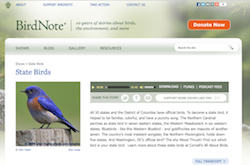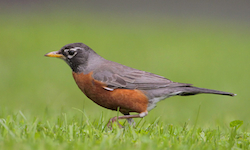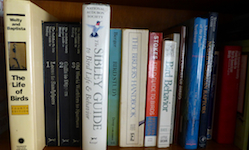

Join BirdNote tomorrow, November 30th!
Illustrator David Sibley and actor H. Jon Benjamin will face off in the bird illustration battle of the century during BirdNote's Year-end Celebration and Auction!
What's your state bird - and why?
A lesson for grades 3-5 in two class periods
 |  |  | ||
| Summary | Lesson Plan | Resources |
Summary
Almost everyone knows that the Bald Eagle is our nation’s bird, but did you know that each state has its own feathered representative? After listening to BirdNote’s podcast on state birds, students will identify their state bird and avian representatives of other states, as well as discover the attributes that helped those birds get elected to office. Students will research their bird's habitat needs and design ways to make their community more bird friendly. This lesson covers learning standards in life science, language arts, speaking and listening, geography, and technology.
Title: Stately State Birds
Duration: Two class periods
Setting: Indoors
Subject Areas: Life Science, Language Arts, Speaking & Listening, Geography
Grade Level: 3-5
Next Generation Science Standards: 3-LS4-3, 3-LS4-4, 3-5-ETS1
Common Core Standards: SL.3.5, SL.4.5, SL.5.5, W.3.8, W.3.7, W.4.8, W.4.7, W.5.7, W.5.8, RI.3.7, RI.4.7, RI.5.7
Lesson Objectives:
• Students will be able to (SWBAT) identify their state bird.
• SWBAT investigate how and/or why a bird was chosen to be the state bird.
• SWBAT research a state bird and identify the habitat needs for that bird.
• Students will attempt to (SWAT) design ways to make their community bird friendly for their state bird and other birds living in their community.
How BirdNote is used: to introduce the concept of state birds
Materials: the BirdNote podcast on state birds, map of United States, pictures of state birds, access to technology (e.g., computers, tablets), if possible.
Lesson Plan
1. Motivate: Ask students to name the bird that is the symbol of the United States of America. Of course it is the Bald Eagle! Ask: Why do you think the Bald Eagle was chosen to be the symbol of our country? Have students brainstorm ideas in their science notebooks using a Thinking Map or another preferred graphic organizer.
2. Teach: Listen to the two-minute BirdNote podcast on state birds. Afterwards ask:
• What were some of the state birds that were mentioned in the podcast?
• Was your state’s bird mentioned?
• Why were the cardinal, meadowlark, bluebird, goldfinch, and mockingbird chosen as state birds?
• How many states chose the cardinal to be their state bird? The bluebird?
• Which bird was chosen to represent the District of Columbia, and how are its attributes different from some of the other birds that were chosen as state birds?
3. Study: Show students a picture of their state bird (laminated pictures or project on Smart Board). Use AllAboutBirds bird guide or bird app to listen to the song of your state bird. Have students discuss why this bird was chosen as the state bird.
4. Do Activity: Separate students into 4 to 5 groups and have students look up their state bird or another state’s bird on a computer or tablet using AllAboutBirds bird guide. Please note that lesson can be supplemented with print material if technology is not available.
When students explore the website, they should:
• Identify at least two cool facts about their state bird.
• Click on the Life History tab for that bird to view the five colorful Life History icons – habitat, food, nesting, behavior, and conservation.
• Click on each of the icons to read about their bird’s habitat needs.
• Record their research on a state bird data sheet.
• When finished, each group can present their state bird to the class. Note: If students are researching the same bird, groups can be assigned a specific life history category to report.
Extension: Based on their research, have students design bird-friendly habitat for their state bird at their school, home, or neighborhood. This can be done on poster board or as a diorama.
Conservation project ideas: Plant bird-friendly native plants around your school to attract your state bird and/or other local native birds. For ideas on how to make your school bird friendly, please visit the AudubonAdventures website.
Resources
Thinking Map
State Birds in Wikipedia
State Birds - a BirdNoteshow (on website or as podcast)
AllAboutBIrds Bird Guide
Audubon Adventures - Taking Action for Birds
Do you have a lesson plan to share? Check out the guidelines, then download the submission form. Thank you!
